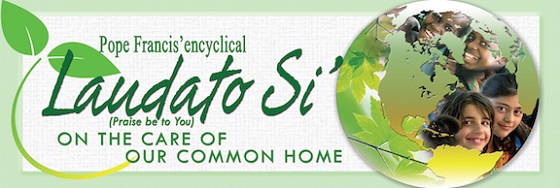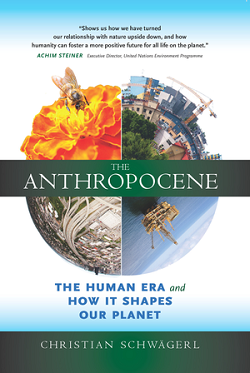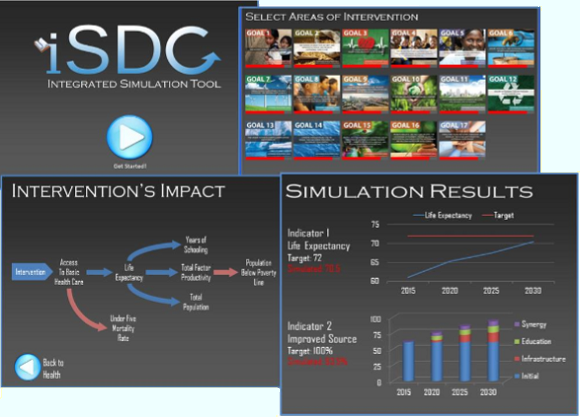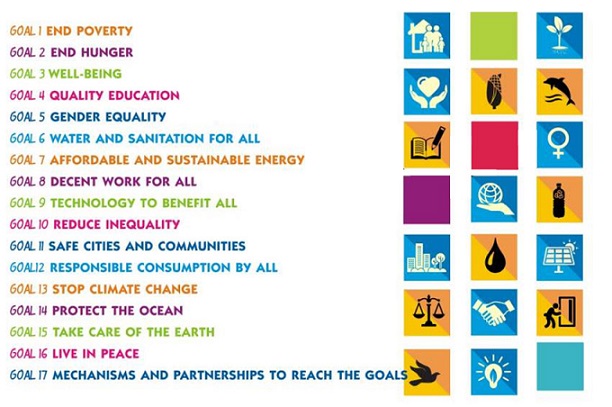|
1. Suggestions for Prayer, Study, and Action
|
Prayer for Good Care of our Common Home

"Triune Lord, wondrous community of infinite love, teach us to contemplate you in the beauty of the universe, for all things speak of you. Awaken our praise and thankfulness for every being that you have made." Pope Francis, Laudato Si’ #217
| |
|
Understanding the Links between Ecology and Human Relations

|
The Anthropocene:
The Human Era and How It Shapes Our Planet
Christian Schwägerl
Synergetic Press, November 2014
"What does it mean to live in a new era, shaped by the global domination of human activity? Schwägerl investigates this question by visiting some of the last pristine places on Earth, exploring rising megacities and witnessing the devastation of forests and coral reefs. The result is this thoroughly researched, comprehensive overview of our planetary situation and outlook. Schwägerl presents tangible solutions to our global crises, and shares his vision of a world that balances ecological sustainability, economic prosperity, political justice and cultural vibrancy."
BOOK WEBSITE
BOOK REVIEW
by John R. Ehrenfeld
Visit this website for more information on the Anthropocene:
ELEMENTA: SCIENCE OF THE ANTHROPOCENE
|
|
|
2. News, Publications, Tools, and Conferences
|
NEWS
|
PUBLICATIONS
|
| |
| |
TOOLS & DATABASES
|
| |
|
CONFERENCES & JOURNALS
|
| |
|
|
3. Advances in Sustainable Development
|
MILLENNIUM DEVELOPMENT GOALS FINAL REPORT 2015
MDG success springboard for new sustainable development agenda
The Millennium Development Goals (MDGs) have produced the most successful anti-poverty movement in history and will serve as the jumping-off point for the new sustainable development agenda to be adopted this year, according to the final MDG report launched today by United Nations Secretary-General Ban Ki-moon.
The Millennium Development Goals Report 2015 found that the 15-year effort to achieve the eight aspirational goals set
out in the Millennium Declaration in 2000 was largely successful across the globe, while acknowledging shortfalls that
remain. The data and analysis presented in the report show that with targeted interventions, sound strategies, adequate
resources and political will, even the poorest can make progress.
"Following profound and consistent gains, we now know that extreme poverty can be eradicated within one more generation", said Ban Ki-moon. "The MDGs have greatly contributed to this progress and have taught us how governments, business and civil society can work together to achieve transformational breakthroughs."
GOALS AND TARGETS WORK
The MDG report confirms that goal-setting can lift millions of people out of poverty, empower women and girls, improve
health and well-being, and provide vast new opportunities for better lives.
Only two short decades ago, nearly half of the developing world lived in extreme poverty. The number of people now living
in extreme poverty has declined by more than half, falling from 1.9 billion in 1990 to 836 million in 2015.
The world has also witnessed dramatic improvement in gender equality in schooling since the MDGs, and gender parity in
primary school has been achieved in the majority of countries.
More girls are now in school, and women have gained ground in parliamentary representation over the past 20 years in
nearly 90 per cent of the 174 countries with data. The average proportion of women in parliament has nearly doubled during
the same period. The rate of children dying before their fifth birthday has declined by more than half, dropping from 90 to
43 deaths per 1,000 live births since 1990. The maternal mortality ratio shows a decline of 45 per cent worldwide, with most
of the reduction occurring since 2000.
Targeted investments in fighting diseases, such as HIV/AIDS and malaria, have brought unprecedented results. Over 6.2
million malaria deaths were averted between 2000 and 2015, while tuberculosis prevention, diagnosis and treatment
interventions saved an estimated 37 million lives between 2000 and 2013.
Worldwide, 2.1 billion have gained access to improved sanitation and the proportion of people practicing open defecation
has fallen almost by half since 1990. Official development assistance from developed countries saw an increase of 66 per cent
in real terms from 2000 and 2014, reaching $135.2 billion.
INEQUALITIES PERSIST
The report highlighted that significant gains have been made for many of the MDG targets worldwide, but progress has been
uneven across regions and countries, leaving significant gaps. Conflicts remain the biggest threat to human development,
with fragile and conflict-affected countries typically experiencing the highest poverty rates.
Gender inequality persists in spite of more representation of women in parliament and more girls going to school. Women
continue to face discrimination in access to work, economic assets and participation in private and public decision-making.
Despite enormous progress driven by the MDGs, about 800 million people still live in extreme poverty and suffer from
hunger. Children from the poorest 20 per cent of households are more than twice as likely to be stunted as those from the
wealthiest 20 per cent and are also four times as likely to be out of school. In countries affected by conflict, the proportion
of out-of-school children increased from 30 per cent in 1999 to 36 per cent in 2012.
In the context of the environment, global emissions of carbon dioxide have increased over 50 per cent since 1990 and water
scarcity now affects 40 per cent of people in the world and is projected to increase.
NEW SUSTAINABLE DEVELOPMENT AGENDA
World leaders have called for an ambitious long-term sustainability agenda to succeed the MDGs. Building on the success
and momentum of the MDGs, new global goals will break fresh ground with ambition on inequalities, economic growth,
decent jobs, cities and human settlements, industrialization, energy, climate change, sustainable consumption and
production, peace and justice.
"The emerging post-2015 development agenda, including the set of Sustainable Development Goals, strives to build on our
successes and put all countries, together, firmly on track towards a more prosperous, sustainable and equitable world,"
concluded Ban Ki-moon.
BACKGROUND
The Millennium Development Goals Report, an annual assessment of global and regional progress towards the Goals,
reflects the most comprehensive, up-to-date data compiled by over 28 UN and international agencies. It is produced by
the UN Department of Economic and Social Affairs. A complete set of the data used to prepare the report is available at
mdgs.un.org. For more information, press materials and an inter-agency media contact list, see
Millennium Development Goals.
Source: United Nations Development Program (UNDP), 6 July 2015
|
4. Advances in Integral Human Development
|
2014 Human Development Report

The 2014 Human Development Report - "Sustaining Human Progress: Reducing Vulnerabilities and Building Resilience" provides a fresh perspective on vulnerability and proposes ways to strengthen resilience.
HIGHLIGHTS
"Persistent vulnerability threatens human development, and unless it is systematically tackled by policies and social norms, progress will be neither equitable nor sustainable.
"According to income-based measures of poverty, 1.2 billion people live with $1.25 or less a day. However, the latest estimates of the UNDP Multidimensional Poverty Index reveal that almost 1.5 billion people in 91 developing countries are living in poverty with overlapping deprivations in health, education and living standards. And although poverty is declining overall, almost 800 million people are at risk of falling back into poverty if setbacks occur.
"By addressing vulnerabilities, all people may share in development progress, and human development will become increasingly equitable and sustainable," stated UNDP Administrator Helen Clark today.
"The 2014 Human Development Report comes at a critical time, as attention turns to the creation of a new development agenda following the 2015 deadline for achieving the Millennium Development Goals.
"Zeroing in on what holds back progress, the report holds that as crises spread ever faster and further, it is critical to understand vulnerability in order to secure gains and sustain progress.
"It points to a slowdown in human development growth across all regions, as measured by the Human Development Index (HDI). It notes that threats such as financial crises, fluctuations in food prices, natural disasters and violent conflict significantly impede progress.
"Reducing both poverty and people's vulnerability to falling into poverty must be a central objective of the post-2015 agenda," the Report states. "Eliminating extreme poverty is not just about 'getting to zero'; it is also about staying there."
"A human development lens on who is vulnerable and why. "Reducing vulnerability is a key ingredient in any agenda for improving human development," writes Nobel laureate Joseph Stiglitz, in a contribution to the Report. "[We] need to approach it from a broad systemic perspective."
"The 2014 Report takes such an approach, using a human development lens to take a fresh look at vulnerability as an overlapping and mutually reinforcing set of risks. It explores structural vulnerabilities - those that have persisted and compounded over time as a result of discrimination and institutional failings, hurting groups such as the poor, women, migrants, people living with disabilities, indigenous groups and older people. For instance, 80 percent of the world's elderly lack social protection, with large numbers of older people also poor and disabled.
"The Report also introduces the idea of life cycle vulnerabilities, the sensitive points in life where shocks can have greater impact. They include the first 1,000 days of life, and the transitions from school to work, and from work to retirement.
"Capabilities accumulate over an individual's lifetime and have to be nurtured and maintained; otherwise they can stagnate and even decline," it warns. "Life capabilities are affected by investments made in preceding stages of life, and there can be long-term consequences of exposure to short-term shocks."
"For example, in one study cited by the Report, poor children in Ecuador were shown to be already at a vocabulary disadvantage by the age of six. Timely interventions-such as investments in early childhood development-are therefore critical, the Report states.
Press release
Summary Report
Full Report
Supporting Data
Supporting Papers
|
5. Advances in Integrated Sustainable Development
6. Sustainability Games, Databases, and Knowledgebases
|
The nexus approach to the sustainable management of water, soil, and waste integrates environmental management and governance across sectors and scales. This approach requires a holistic understanding of the interlinkage of all related environmental processes, while also taking into consideration global change and socioeconomic aspects.
Exploring these interlinkages and advancing a nexus-oriented management approach requires integrated modeling tools. However, no single modeling tool is available or conceivable that can cover all processes, interactions and drivers related to the management of water, soil and waste resources.
To help overcome this challenge, the UNU Institute for Integrated Management of Material Fluxes and of Resources (UNU-FLORES) has developed an interactive Nexus Tools Platform (NTP) for comparison of existing modelling tools related to the water-soil-waste nexus. Currently, the NTP database consists of 60 models from around the world. The platform provides detailed model information and advanced filtering based on real-time visualizations, and will continuously grow with the input and feedback from model developers and model users.
For more information see the UNU-FLORES website and the Nexus Tools Platform.
|
7. Sustainable Development Measures and Indicators
8. Sustainable Development Modeling and Simulation
Threshold 21 iSDG Simulation Model
Millennium Institute, May 2015

Millennium Institute is developing models that will enable policy makers and planning officials at all levels of governance to understand the interconnectedness of policies designed to achieve the SDGs and test their likely impacts before adopting them. For more information about the model and to preview the demo version contact info@millennium-institute.org.
|
|
"C-ROADS is an award-winning computer simulation that helps people understand the long-term climate impacts of policy scenarios to reduce greenhouse gas emissions. It allows for the rapid summation of national greenhouse gas reduction pledges in order to show the long-term impact on our climate." For more information, click
here.
Click here to view a larger version of the video.
Visit Climate Interactive for updates and announcements.
|
9. Fostering Sustainability in the International Community
|
The scale of the global sustainable development challenge is unprecedented. The fight against extreme poverty has made great progress under the Millennium Development Goals (MDGs), but more than 1 billion people continue to live in extreme poverty. Inequality and social exclusion are widening within most countries. With the world at 7 billion people and current annual GDP of US$70 trillion, human impacts on the environment have already reached dangerous levels. As the world population is estimated to rise to 9 billion by 2050
and global GDP to more than US$200 trillion, the world urgently needs a framework for sustainable development that addresses the challenges of ending poverty, increasing social inclusion, and sustaining the planet.
Under the auspices of the UN Secretary-General, and in line with the recently launched High-level Panel of Eminent Persons on the Post-2015 Development Agenda, the Sustainable Development Solutions Network (SDSN) was announced on August 9, 2012 and will provide global, open and inclusive support to sustainable-development problem solving at local, national, and global scales. The SDSN will work together with United Nations agencies, other international organizations, and the multilateral funding institutions including the World Bank and regional development banks, to mobilize scientific and technical expertise to scale up the magnitude and quality of local, national and global problem solving, helping to identify solutions and highlighting best practices in the design of long-term development pathways.
Indicators for Sustainable Development Goals
SDSN, 14 February 2014
|
|
"A new report issued today by a top-level United Nations knowledge network under the auspices of UN Secretary General Ban Ki-moon lays out an action agenda to support global efforts to achieve sustainable development during the period 2015-2030.
"The post-2015 process is a chance for the global community to work towards a new era in sustainable development," said UN Secretary-General Ban Ki-moon. "The latest report from the Sustainable Development Solutions Network, the result of a collaboration between top scientists, technologists, businesses, and development specialists, is a critical input to the work we are doing to shape an ambitious and achievable post-2015 agenda." To download the report, click here.
Promotion of the Post-2015 Development Agenda
Source:
How the United Nations Should Promote the Post-2015 Development Agenda
Kara Alaimo, Center for Governance and Sustainability, University of Massachusetts - Boston
Sustainable Development Goals

Source:
The politics of the Sustainable Development Goals (SDGs)
Dario Kenner, Why Green Economy?, June 2015
|
|